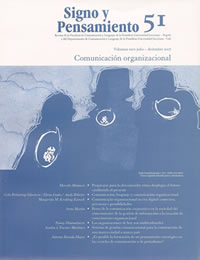Abstract
During the last decades, brand management has increased to become a topic of compulsory discussion among local and national governments, as well as among private and public organizations. This new aspect of management is of great importance, since if well planned, it may reveal important achievements in the competitiveness and image of cities and countries. Therefore, the purpose of this paper is to approach the concept of integral branding from the perspective of a communication management system comprising three sub-systems: management environment, brand structuring, and link construction.Borja, J. (2002, febrero-mayo), “La ciudad y la nueva ciudadanía”, en La Factoría [en línea], núm. 17, disponible en: http://www.lafactoriaweb.com/articulos/borja17.htm.
Casado, S. (2006), “Estudio sobre la marca-país en el mundo”, en Boletín Especial del Centro de Investigación de Imagen y Comunicación [en línea], núm. 2, Mendoza, Universidad de Congreso, disponible en: http://www.ucongreso.edu.ar/investigacion/imagencomunicacion/
Bol2/Estudio%20marca%20 pais.pdf.
Costa, J. (1977), La imagen de la empresa. Métodos de comunicación integral, Madrid, Ibérico Europea de Ediciones.
— (1999a), La comunicación en acción, Barcelona, Paidós.
— (1999b), Imagen corporativa en el siglo XXI, Buenos Aires, La Crujía.
— (2004a), La imagen de marca, Barcelona, Paidós.
— (2004b), Dircom on-line, La Paz, Grupo Editorial Design.
Ferry, J. y Kevan, A. (2001), Dirección estratégica, Madrid, Prentice Hall.
FutureBrand (2006), Country Brand Index (cbi), s.d. [informe empresarial]
iii Congreso Internacional de Comunicación Organizacional ( 2003 – Joan Costa. f.), Presentación [en línea], disponible en: http://www.javeriana.edu.co/Facultades/comunicacion_lenguaje/memorias_organizacional/tercero/presentacion.htm.
Manucci, M. (2004), Comunicación corporativa estratégica, Bogotá, saf.
Memorias del I Congreso Internacional de Comunicación Organizacional (2003), Bogotá, Pontificia Universidad Javeriana.
Peñalosa, E. (2002), La ciudad y la igualdad [en línea], Fundación por el País que Queremos, disponible en: http://www.porelpaisquequeremos.com/documentos/030604_La_Ciudad_y_la_Igualdad.pdf.
Pizzolante, I. (2004a, febrero-marzo), “El gobierno corporativo y la realidad latinoamericana. Entrevista a Italo Pizzolante”, en Razón y Palabra [en línea], disponible en: http://www.cem.itesm.mx/dacs/publicaciones/logos/anteriores/n37/ipizzolante.html
— (2004b), El poder de la comunicación estratégica, Bogotá, Editorial Pontificia Universidad Javeriana.
Ritter, M. (2004), Imagen y reputación, s. d. Sánchez, E. D. (s. f.), El hombre y las marcas. La identidad visual de la marca Argentina: un ensayo antropológico [en línea], disponible en: http://www.argentina.ar/advf/documentos/474f3210c100a0.75169375.pdf.
Seisdedos, H. (2006), “La marca ciudad como antídoto para la ‘bonsainización’ del city marketing”,
en Harvard Deusto Marketing y Ventas [en línea], núm. 76, pp. 46-53, disponible en:http://citymarketing.biz/casos/la-marca-ciudad-como-antidoto-para-la-bonsainizaciondel-city-marketing.
Villafañe, J. (2006), Las seis claves de la reputación interna, Madrid, Pearson Prentice Hall.

This work is licensed under a Creative Commons Attribution 4.0 International License.
Copyright (c) 2021 Sandra I. Fuentes Martínez


